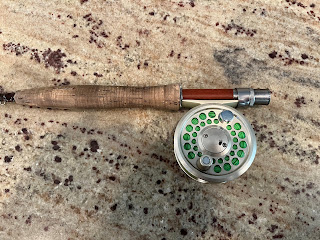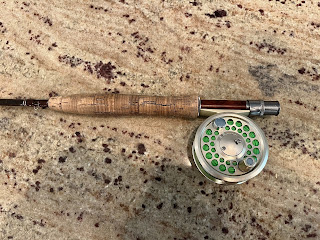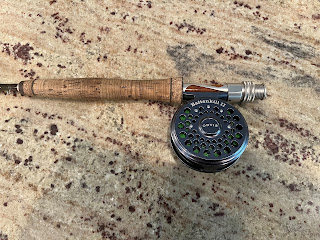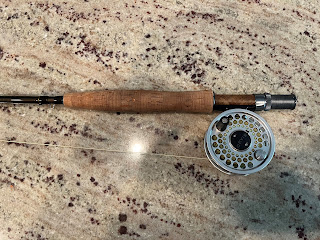When some individuals buy a fly rod they like to pair it with a fly reel that gives them balance with the reel size, its weight, and the weight of the fly rod. When it comes to balancing a fly reel and fly rod it all depends on where you move your forefinger on the cork handle to get the reel and rod to sit in a straight horizontal position. I know a lot of you guys use this method to balance a combo you are purchasing and a lot of fly fishing shops adhere to this method.
I hope to use this blog as an avenue to express my thoughts and adventures of all of my fishing expeditions and any other journeys I may undertake.
Saturday, January 29, 2022
Pairing Fly Rods With Fly Reels
Thursday, October 8, 2020
Fall Bass Fishing
Fall is a great time of the year to fish for bass on your favorite lake. The species could be Largemouth, Smallmouth, or Spotted Bass. Jeff and I spent the morning casting surface poppers fishing for the Largemouth and Spotted Bass in areas around Duncan Bridge launch on Smith Lake. The weather was a little cool to start the morning but landing those first fish took the chill out. Nice spotted bass early fishing a wall near docks--Jeffs five weight got quite a workout landing this bass!Always fish walls like this more than once, the first run rewarded Jeff with the bass in above image.The next run produced this female spotted bass on a Barr Nunn popper, which made my 5 wt. sing. Sorry to say the third run told us to move on!
Sunday, September 27, 2020
The "Best Cast" Fly Line
First off guys I'm no expert when it comes to fly lines. I do know when the fly line I'm using isn't performing to its potential. After doing the post on furled leaders; I thought, wouldn't be nice if I could find a fly line that was limp and had no memory like the furled leader I've started using. Enter the SF Best Cast fly line that can be described in a few sentences. First, this line has no memory at all and is as limp as the furled leader I'm using now. The ease of casting this line has really impressed me for distance casting and accuracy in placing the fly or popper I might be using. Also, this line doesn't tangle when you have line pulled off the reel getting ready for your next cast. I intend to have all my fly reels spooled with the Best Cast line by next season.
Oh, I forgot to mention, the best part about this line is the price. It comes in 100 ft and 90 ft. length and is priced at 16.99 with free shipping at Amazon. I am using the dark green color instead of the bright yellow on a couple of my reels now. It comes in sizes 1 through 10 line wt. and has the welded loop on both ends.
This 2 lb spot put this line through the tangle test factor yesterday as I rushed to get him on the reel. No tangle line at all as this fish strips drag time and again.
He nailed a Bullet Boogle Bug as I slowly moved it away from a rock ledge, fishing Brushy Creek on Smith Lake. The Spotted Bass were active early yesterday hitting a number of different poppers I cast their way.
Saturday, September 5, 2020
The Furled Leader
How many of you guys have fly fishing accessories that lie useless for years in a drawer, box, or bag? While rambling through one of my many drawers of fly fishing stuff the other day I discovered this furled leader that I found. After researching my blog I discover I did a post concerning this leader fishing the Sipsey in 2016 but never used it that day. I thought as I examined the package that it would be a good replacement for my 4 weight mono leader I had been using for years. Once I buy a leader the first thing I do is replace the tippet end of the leader with a tippet ring. By doing that I can tie on tippet after tippet of 3 ft. or longer for a number of seasons. I applied the same procedure to this new furled leader.
A few false cast in the back yard convinced me that it was worth giving a try on the trip I had planned on Smith last Thursday. I was using the leader with my 4 weight 9 ft. Redington. My first cast using this leader showed me the difference in the mono leader I had been using for years versus the furled leader. I was impressed with the ease of casting especially in the wind that was occurring at times that morning. The info on the package indicated it was made with Uni-thread as opposed to the mono strands used to construct mono furled leaders. The mono furled leaders are much stiffer and retain memory. The Uni-thread gives the leader the ability to have no memory. In other words, no bend in your leader line. It cast accurate and landed lightly on the water. I also noticed that on my line pick-up from the water surface there is no spray water. My favorite characteristic of this leader is the no memory factor which reduces drag when fishing dries or nymphs. It floats quite well on the surface without sinking and affecting the action of the fly or popper. I read where one can add some floatant if they prefer. I'm still using it without floatant.
After doing a little research on the leader I found they are made in 4, 5, 6, or 7 ft. lengths. The one I am using is a 6 ft. length with the tippet ring attached. This leader will last me the rest of the season and even into next season. I found no fly shops carrying these leaders because they are constructed most of the time by individuals and are not factory-made. I'm so impressed I'm already in the process of searching Ebay for more Uni-thread leaders. In fact, I will be using all furled leaders for the next season.
Sunday, July 26, 2020
The Versatile Soft Hackle Fly
Thursday, July 16, 2020
Seeing Spots
Wednesday, July 8, 2020
The Elusive 9 Foot 3 Weight Fly Rod
What makes this fly rod so special? First and foremost is the fact that it is graphite, extremely lightweight with medium-fast action; perfect for distance casting, and delivering a dry fly or tiny popper feather-light on the surface film. In other words, you want your fly or popper to imitate a small insect dropping from a tree limb onto the surface of the water. This particular fly rod has the features to do that. The extra length gives you the ability to be much more accurate with your presentation. How do I know that this fly rod possesses all the characteristics I have stated because I've been fishing with one for the past 14 years? I have written a few posts over the years on this blog about my Greys Streamflex FX2 9 ft. 3 weight.
In my search yesterday I found out that this Streamflex is no longer sold through Greys website. So I better take care of the one I fish with. I also found an Echo 9 ft. 3 weight priced at 230.00 which is no longer made. The only 9 ft. 3 weight I found available was the Redington Crux, which is priced at 325,00 total with free shipping. I fish Redington fly rods and know how special these rods are. 325 is a little pricy for me but if I break my Streamflex this may be the flyrod I will purchase.
It is amazing to me why fly rod manufacturers don't know how well these fly rods would sell. It makes one wonder if any market research has been done on this particular fly rod. Orvis one of the largest fly fishing companies in the nation told me yesterday that they don't carry a 9 ft. 3 weight fly rod? Those of us who own this"rare" fly rod, better whole on to them, because they will increase in value over the years. I know I could sell my Streamflex on Ebay today and get what I paid for it and maybe even more! -----not going to happen!!!
If any of you guys find this fly rod at a reasonable price please leave a comment.
Sunday, June 21, 2020
Landing a Hugh Spotted Bass
Tuesday, May 19, 2020
Landing Quality Size Bluegill
Wednesday, May 6, 2020
Awesome Morning Fishing the Dry Fly "Gnat"
The metal stairs of access six was a welcome site Tuesday morning as I made my way down to the gorge to fish the Sipsey for the first time this year. Heavy rains have kept it high and out of its banks for most of the Spring. So to say I was ready to fish was an understatement. As I set foot on the wet slippery rocks at the bottom of the stairs I was met by a young couple from Birmingham fishing with spinning gear in a distance. There was one more individual fishing upstream. I couldn't believe I partially had the place to myself. I decided to start working in an area I hadn't fished since last fall which was near the dam at access 7. As I made my way to the area I notice the trout were feeding sparingly on top, which I had seen before numerous times here. So the most logical fly for me to try was one I 'd fished many times before here and that was the size 20 "Gnat". When in doubt what dry fly to use on the Sipsey with no hatch try the Gant.
Wednesday, February 27, 2019
Rain, Ice and Disney World
Thursday, March 1, 2018
Flexing the Muscle of the 2 Weight
The Redington medium action fly rod paired with the Redington Drift reel yields one fantastic day on the water.


















































